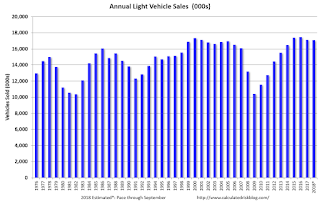by Calculated Risk on 11/02/2018 06:31:00 PM
Friday, November 02, 2018
Q4 GDP Forecasts
From Goldman Sachs:
Q4 2.6% (qoq ar). [Oct 29 estimate].From Merrill Lynch:
emphasis added
[W]e revise down 4Q GDP to 2.8% from 3.0% [Nov 2 estimate].And from the Altanta Fed: GDPNow
The GDPNow model estimate for real GDP growth (seasonally adjusted annual rate) in the fourth quarter of 2018 is 2.9 percent on November 2, down from 3.0 percent on November 1. [Nov 2 estimate]From the NY Fed Nowcasting Report
The New York Fed Staff Nowcast for 2018:Q4 stands at 2.6%. [Nov 2 estimate]CR Note: These early estimates suggest GDP in the high 2s for Q4.
October Vehicles Sales: 17.5 Million SAAR
by Calculated Risk on 11/02/2018 03:47:00 PM
The BEA released their estimate of October vehicle sales. The BEA estimated sales of 17.51 million SAAR in October 2018 (Seasonally Adjusted Annual Rate), up 0.5% from the September sales rate, and down 2.0% from October 2017.
Through October, light vehicle sales are on pace to be mostly unchanged in 2018 compared to 2017.
This would make 2018 the fifth best year on record after 2016, 2015, 2000, and 2017.
Click on graph for larger image.
This graph shows annual light vehicle sales since 1976. Source: BEA.
Sales for 2018 are estimated based on the pace of sales during the first ten months.
The second graph shows light vehicle sales since the BEA started keeping data in 1967.

My guess is vehicle sales will finish the year with sales lower than in 2017 (sales in late 2017 were boosted by buying following the hurricanes), and will probably be just over 17 million for the year (the lowest since 2014).
A small decline in sales this year isn't a concern - I think sales will move mostly sideways at near record levels.
As I noted last year, this means the economic boost from increasing auto sales is over (from the bottom in 2009, auto sales boosted growth every year through 2016).
Public and Private Sector Payroll Jobs During Presidential Terms
by Calculated Risk on 11/02/2018 03:22:00 PM
By request, here is another update of tracking employment during Presidential terms. We frequently use Presidential terms as time markers - we could use Speaker of the House, Fed Chair, or any other marker.
NOTE: Several readers have asked if I could add a lag to these graphs (obviously a new President has zero impact on employment for the month they are elected). But that would open a debate on the proper length of the lag, so I'll just stick to the beginning of each term.
Important: There are many differences between these periods. Overall employment was smaller in the '80s, however the participation rate was increasing in the '80s (younger population and women joining the labor force), and the participation rate is generally declining now. But these graphs give an overview of employment changes.
The first graph shows the change in private sector payroll jobs from when each president took office until the end of their term(s). Presidents Carter and George H.W. Bush only served one term.
Mr. G.W. Bush (red) took office following the bursting of the stock market bubble, and left during the bursting of the housing bubble. Mr. Obama (dark blue) took office during the financial crisis and great recession. There was also a significant recession in the early '80s right after Mr. Reagan (dark red) took office.
There was a recession towards the end of President G.H.W. Bush (light purple) term, and Mr Clinton (light blue) served for eight years without a recession.

The first graph is for private employment only.
Mr. Trump is in Orange (21 months).
The employment recovery during Mr. G.W. Bush's (red) first term was sluggish, and private employment was down 804,000 jobs at the end of his first term. At the end of Mr. Bush's second term, private employment was collapsing, and there were net 391,000 private sector jobs lost during Mr. Bush's two terms.
Private sector employment increased by 20,964,000 under President Clinton (light blue), by 14,717,000 under President Reagan (dark red), 9,041,000 under President Carter (dashed green), 1,509,000 under President G.H.W. Bush (light purple), and 11,907,000 under President Obama (dark blue).
During the first 21 months of Mr. Trump's term, the economy has added 3,970,000 private sector jobs.

The public sector grew during Mr. Carter's term (up 1,304,000), during Mr. Reagan's terms (up 1,414,000), during Mr. G.H.W. Bush's term (up 1,127,000), during Mr. Clinton's terms (up 1,934,000), and during Mr. G.W. Bush's terms (up 1,744,000 jobs). However the public sector declined significantly while Mr. Obama was in office (down 266,000 jobs).
During the first 21 months of Mr. Trump's term, the economy has added 84,000 public sector jobs.

After 21 months of Mr. Trump's presidency, the economy has added 4,054,000 jobs, about 321,000 behind the projection.
Trade Deficit increased to $54.0 Billion in September
by Calculated Risk on 11/02/2018 11:51:00 AM
Earlier from the Department of Commerce reported:
The U.S. Census Bureau and the U.S. Bureau of Economic Analysis announced today that the goods and services deficit was $54.0 billion in September, up $0.7 billion from $53.3 billion in August, revised.
September exports were $212.6 billion, $3.1 billion more than August exports. September imports were $266.6 billion, $3.8 billion more than August imports.
 Click on graph for larger image.
Click on graph for larger image.Exports and imports increased in September.
Exports are 29% above the pre-recession peak and up 7% compared to September 2017; imports are 15% above the pre-recession peak, and up 10% compared to September 2017.
In general, trade has been picking up.
The second graph shows the U.S. trade deficit, with and without petroleum.
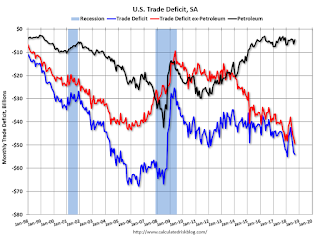 The blue line is the total deficit, and the black line is the petroleum deficit, and the red line is the trade deficit ex-petroleum products.
The blue line is the total deficit, and the black line is the petroleum deficit, and the red line is the trade deficit ex-petroleum products.Oil imports averaged $61.35 in September, down from $62.63 in August, and up from $45.13 in September 2017.
The trade deficit with China increased to $40.2 billion in September, from $34.50 billion in September 2017.
Comments on October Employment Report
by Calculated Risk on 11/02/2018 09:31:00 AM
The headline jobs number at 250,000 for October was above consensus expectations of 190 thousand (probably boosted by some bounce back from Hurricane Florence), and the previous two months were unrevised combined. The unemployment rate was unchanged at 3.7%. Overall this was a strong report.
Earlier: October Employment Report: 250,000 Jobs Added, 3.7% Unemployment Rate
In October, the year-over-year employment change was 2.516 million jobs. This is solid year-over-year growth.
Average Hourly Earnings
Wage growth was above expectations in October. From the BLS:
"In October, average hourly earnings for all employees on private nonfarm payrolls rose by 5 cents to $27.30. Over the year, average hourly earnings have increased by 83 cents, or 3.1 percent."
 Click on graph for larger image.
Click on graph for larger image.This graph is based on “Average Hourly Earnings” from the Current Employment Statistics (CES) (aka "Establishment") monthly employment report. Note: There are also two quarterly sources for earnings data: 1) “Hourly Compensation,” from the BLS’s Productivity and Costs; and 2) the Employment Cost Index which includes wage/salary and benefit compensation.
The graph shows the nominal year-over-year change in "Average Hourly Earnings" for all private employees. Nominal wage growth was at 3.1% YoY in October.
Wage growth has generally been trending up.
Prime (25 to 54 Years Old) Participation
 Since the overall participation rate has declined due to cyclical (recession) and demographic (aging population, younger people staying in school) reasons, here is the employment-population ratio for the key working age group: 25 to 54 years old.
Since the overall participation rate has declined due to cyclical (recession) and demographic (aging population, younger people staying in school) reasons, here is the employment-population ratio for the key working age group: 25 to 54 years old.In the earlier period the participation rate for this group was trending up as women joined the labor force. Since the early '90s, the participation rate moved more sideways, with a downward drift starting around '00 - and with ups and downs related to the business cycle.
The 25 to 54 participation rate increased in October to 82.3%, and the 25 to 54 employment population ratio increased to 79.7%.
Part Time for Economic Reasons
 From the BLS report:
From the BLS report:"The number of persons employed part time for economic reasons (sometimes referred to as involuntary part-time workers) was essentially unchanged at 4.6 million in October. These individuals, who would have preferred full-time employment, were working part time because their hours had been reduced or they were unable to find full-time jobs."The number of persons working part time for economic reasons has been generally trending down. The number decreased slightly in October. The number working part time for economic reasons suggests there is still a little slack in the labor market.
These workers are included in the alternate measure of labor underutilization (U-6) that decreased to 7.4% in October.
Unemployed over 26 Weeks
 This graph shows the number of workers unemployed for 27 weeks or more.
This graph shows the number of workers unemployed for 27 weeks or more. According to the BLS, there are 1.373 million workers who have been unemployed for more than 26 weeks and still want a job. This was down slightly from 1.384 million in September.
Summary:
The headline jobs number was above expectations. The headline unemployment rate was unchanged at 3.7%, tying last month for the lowest rate since 1969. And wage growth was above expectations, and above 3% YoY for the first time in over 9 years.
Overall, this was a strong report. For the first ten months of 2018, job growth has been solid, averaging 213 thousand per month.
October Employment Report: 250,000 Jobs Added, 3.7% Unemployment Rate
by Calculated Risk on 11/02/2018 08:42:00 AM
From the BLS:
Total nonfarm payroll employment rose by 250,000 in October, and the unemployment rate was unchanged at 3.7 percent, the U.S. Bureau of Labor Statistics reported today. Job gains occurred in health care, in manufacturing, in construction, and in transportation and warehousing.
Hurricane Michael made landfall in the Florida Panhandle on October 10, 2018, during the reference periods for both the establishment and household surveys. Hurricane Michael had no discernible effect on the national employment and unemployment estimates for October, and response rates for the two surveys were within normal ranges.
...
The change in total nonfarm payroll employment for September was revised down from +134,000 to +118,000, and the change for August was revised up from +270,000 to +286,000. The downward revision in September offset the upward revision in August.
...
In October, average hourly earnings for all employees on private nonfarm payrolls rose by 5 cents to $27.30. Over the year, average hourly earnings have increased by 83 cents, or 3.1 percent.
emphasis added
 Click on graph for larger image.
Click on graph for larger image.The first graph shows the monthly change in payroll jobs, ex-Census (meaning the impact of the decennial Census temporary hires and layoffs is removed - mostly in 2010 - to show the underlying payroll changes).
Total payrolls increased by 250 thousand in October (private payrolls increased 246 thousand).
Payrolls for August and September were unchanged combined.
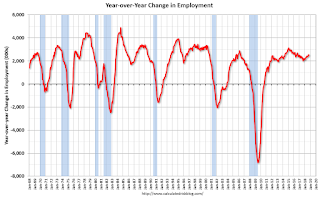 This graph shows the year-over-year change in total non-farm employment since 1968.
This graph shows the year-over-year change in total non-farm employment since 1968.In October the year-over-year change was 2.516 million jobs.
The third graph shows the employment population ratio and the participation rate.
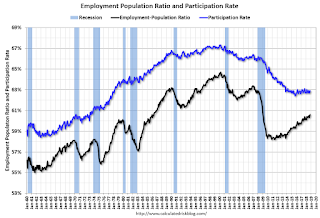 The Labor Force Participation Rate increased in October to 62.9%. This is the percentage of the working age population in the labor force. A large portion of the recent decline in the participation rate is due to demographics and long term trends.
The Labor Force Participation Rate increased in October to 62.9%. This is the percentage of the working age population in the labor force. A large portion of the recent decline in the participation rate is due to demographics and long term trends.The Employment-Population ratio increased to 60.6% (black line).
I'll post the 25 to 54 age group employment-population ratio graph later.
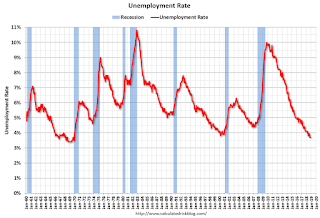 The fourth graph shows the unemployment rate.
The fourth graph shows the unemployment rate. The unemployment rate was unchanged in October at 3.7%.
This was above consensus expectations of 190,000 jobs. A strong report.
I'll have much more later ...
Thursday, November 01, 2018
Friday: Employment Report, Trade Deficit
by Calculated Risk on 11/01/2018 09:04:00 PM
My October Employment Preview
Goldman: October Payrolls Preview
Friday:
• At 8:30 AM, Employment Report for October. The consensus is for 190,000 jobs added, and for the unemployment rate to be unchanged at 3.7%.
• Also at 8:30 AM, Trade Balance report for September from the Census Bureau. The consensus is the trade deficit to be $53.4 billion. The U.S. trade deficit was at $53.2 billion in August.
Goldman: October Payrolls Preview
by Calculated Risk on 11/01/2018 06:50:00 PM
A few brief excerpts from a note by Goldman Sachs economist Spencer Hill:
We estimate nonfarm payrolls increased 210k in October, somewhat above consensus of +200k. Our forecast reflects a 15k net boost from weather … We expect the unemployment rate to remain at 3.7% in tomorrow’s report. …CR: Note that Goldman expects a 15,000 net boost from weather (bounce back from Hurricane Florence minus impact from Hurricane Michael.
We estimate average hourly earnings increased 0.1% month over month and 3.0% year-over-year ...
emphasis added
October Employment Preview
by Calculated Risk on 11/01/2018 12:53:00 PM
On Friday at 8:30 AM ET, the BLS will release the employment report for October. The consensus is for an increase of 190,000 non-farm payroll jobs in October (with a range of estimates between 150,000 to 231,000), and for the unemployment rate to be unchanged at 3.7%.
The BLS reported 134,000 jobs added in September.
Here is a summary of recent data:
• The ADP employment report showed an increase of 227,000 private sector payroll jobs in October. This was well above consensus expectations of 180,000 private sector payroll jobs added. The ADP report hasn't been very useful in predicting the BLS report for any one month, but in general, this suggests employment growth above expectations.
• The ISM manufacturing employment index decreased in October to 56.8%. A historical correlation between the ISM manufacturing employment index and the BLS employment report for manufacturing, suggests that private sector BLS manufacturing payroll increased about 17,000 in October. The ADP report indicated manufacturing jobs increased 17,000 in October.
The ISM non-manufacturing report has not been released yet.
• Initial weekly unemployment claims averaged 214,000 in October, up from 207,000 in September. For the BLS reference week (includes the 12th of the month), initial claims were at 210,000, up from 202,000 during the reference week the previous month.
The increase during the reference week suggests a slightly weaker employment report in October.
• The final October University of Michigan consumer sentiment index decreased to 98.6 from the September reading of 100.1. Sentiment is frequently coincident with changes in the labor market, but there are other factors too like gasoline prices and politics.
• Merrill Lynch has introduced a new payrolls tracker based on private internal BAC data. The tracker suggests private payrolls increased by 200,000 in October, and this suggests employment growth slightly above expectations.
• Looking back at the three previous years:
In October 2017, the consensus was for 325,000 jobs, and the BLS reported 261,000 jobs added (bounce back from Hurricane).
In October 2016, the consensus was for 178,000 jobs, and the BLS reported 161,000 jobs added.
In October 2015, the consensus was for 190,000 jobs, and the BLS reported 271,000 jobs added.
There is no clear pattern comparing consensus to actual for October.
• The hurricanes make the forecast even less certain this month.
• Conclusion: These reports suggest a solid employment report in October. It seems likely there will be some bounce back following Hurricane Florence, but Hurricane Michael might negatively impact the report. My guess is the report will be close to the consensus.
Construction Spending increased slightly in September
by Calculated Risk on 11/01/2018 11:26:00 AM
From the Census Bureau reported that overall construction spending increased slightly in September:
Construction spending during September 2018 was estimated at a seasonally adjusted annual rate of $1,329.5 billion, nearly the same as the revised August estimate of $1,328.8 billion. The September figure is 7.2 percent above the September 2017 estimate of $1,240.4 billion.Private spending increased and public spending decreased:
Spending on private construction was at a seasonally adjusted annual rate of $1,020.4 billion, 0.3 percent above the revised August estimate of $1,016.9 billion. ...
In September, the estimated seasonally adjusted annual rate of public construction spending was $309.1 billion, 0.9 percent below the revised August estimate of $312.0 billion.
emphasis added
 Click on graph for larger image.
Click on graph for larger image.This graph shows private residential and nonresidential construction spending, and public spending, since 1993. Note: nominal dollars, not inflation adjusted.
Private residential spending had been increasing - although has declined slightly recently - and is still 18% below the bubble peak.
Non-residential spending is 12% above the previous peak in January 2008 (nominal dollars).
Public construction spending is now 5% below the peak in March 2009, and 18% above the austerity low in February 2014.
 The second graph shows the year-over-year change in construction spending.
The second graph shows the year-over-year change in construction spending.On a year-over-year basis, private residential construction spending is up 5%. Non-residential spending is up 7% year-over-year. Public spending is up 11% year-over-year.
This was below consensus expectations, however spending for July and August were revised up.

